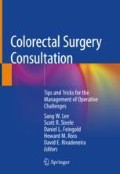Abstract
Port placement for laparoscopic surgery in patients who have had prior surgeries can be complicated by the presence of anterior abdominal wall adhesions. To avoid inadvertent bowel injury, it is important to choose the location of the first laparoscopic port carefully. An important principal for laparoscopic port placement in the reoperative abdomen includes placement of ports away from prior operative sites. There is no statistical difference in rates of bowel injury between access to the abdomen achieved by open or closed laparoscopic entry, and method of entry should be determined by individual surgeon comfort and familiarity with entry method.
Access this chapter
Tax calculation will be finalised at checkout
Purchases are for personal use only
Suggested Reading
Ahmad G, Gent D, Henderson D, O’Flynn H, Phillips K, Watson A. Laparoscopic entry techniques. Cochrane Database Syst Rev. 2015;(8):CD006583. https://doi.org/10.1002/14651858.CD006583.pub4.
Argarwala N. Safe entry techniques during laparoscopy: left upper quadrant entry using the ninth intercostal space—a review of 918 procedures. J Minim Invasive Gynecol. 2005;12(1):55–61.
Bhoyrul S, Vierra MA, Nezhat CR, Krummel TM, Way LW. Trocar injuries in laparoscopic surgery. J Am Coll Surg. 2001;192(6):677–83.
Chang FH, Chou HH, Lee CL, Cheng PJ, Wang CW, Soong YK. Extraumbilical insertion of the operative laparoscope in patients with extensive intraabdominal adhesions. J Am Assoc Gynecol Laparosc. 1995;2(3):335–7.
Childers J, Brzechffa P, Surwit E. Laparoscopy using the left upper quadrant as the primary trocar site. Gynecol Oncol. 1993;50(2):221–5.
Englum BR, Hopkins MB, Migaly J. Overcoming technical challenges: reoperative surgery. In: Ross H, Lee S, Mutch M, Rivadeneira D, Steele S, editors. Minimally invasive approaches to colon and rectal disease. New York: Springer; 2015.
Kothari SN, Fundell LJ, Lambert PJ, Mathiason MA. Use of transabdominal ultrasound to identify intraabdominal adhesions prior to laparoscopy: a prospective blinded study. Am J Surg. 2006;192(6):843–7, ISSN 0002-96101.
Kumar S. Veress needle insertion through left lower intercostal space for creating pneumoperitoneum: experience with 75 cases. J Minim Access Surg. 2012;8(3):85–9. https://doi.org/10.4103/0972-9941.97590.
Parker J, Reid G, Wong F. Microlaparoscopic left upper quadrant entry in patients at high risk of periumbilical adhesions. Aust N Z J Obstet Gynaecol. 1999;39:88–92. https://doi.org/10.1111/j.1479-828X.1999.tb03452.x.
Read TE, Salgado J, Ferraro D, et al. “Peek port”: a novel approach for avoiding conversion in laparoscopic colectomy. Surg Endosc. 2009;23:477. https://doi.org/10.1007/s00464-008-0047-1.
Tinelli A, Malvasi A, Guido M, Tsin DA, Hudelist G, Stark M, Mettler L. Laparoscopy entry in patients with previous abdominal and pelvic surgery. Surg Innov. 2011;18(3):201–5. https://doi.org/10.1177/1553350610393989. Epub 2011 Jan 18.
Tittel A, Treutner KH, Titkova S, et al. New adhesion formation after laparoscopic and conventional adhesiolysis. Surg Endosc. 2001;15:44. https://doi.org/10.1007/s004640000256.
van der Voort M, Heijnsdijk EA, Gouma DJ. Bowel injury as a complication of laparoscopy. Br J Surg. 2004;91(10):1253–8.
Van Goor H. Consequences and complications of peritoneal adhesions. Color Dis. 2007;9(S2):25–34.
Author information
Authors and Affiliations
Corresponding author
Editor information
Editors and Affiliations
Rights and permissions
Copyright information
© 2019 Springer Nature Switzerland AG
About this chapter
Cite this chapter
Greco, L., Ross, H.M. (2019). Entering the Reoperative Hostile Abdomen Laparoscopically. In: Lee, S., Steele, S., Feingold, D., Ross, H., Rivadeneira, D. (eds) Colorectal Surgery Consultation. Springer, Cham. https://doi.org/10.1007/978-3-030-11181-6_46
Download citation
DOI: https://doi.org/10.1007/978-3-030-11181-6_46
Published:
Publisher Name: Springer, Cham
Print ISBN: 978-3-030-11180-9
Online ISBN: 978-3-030-11181-6
eBook Packages: MedicineMedicine (R0)

